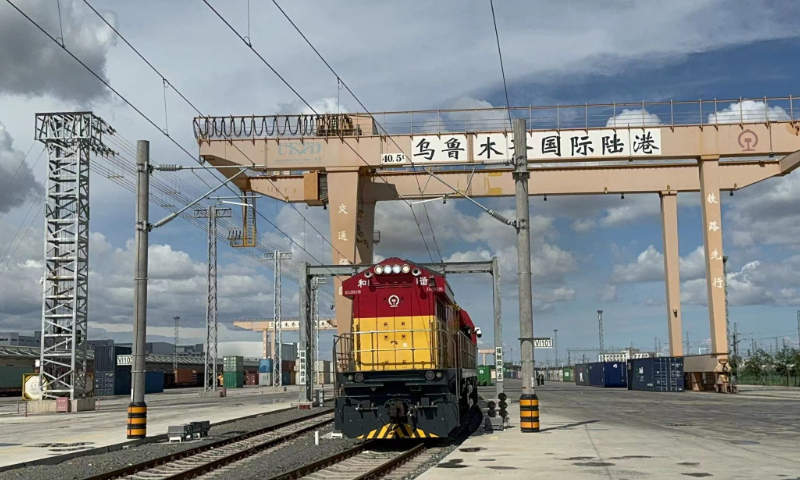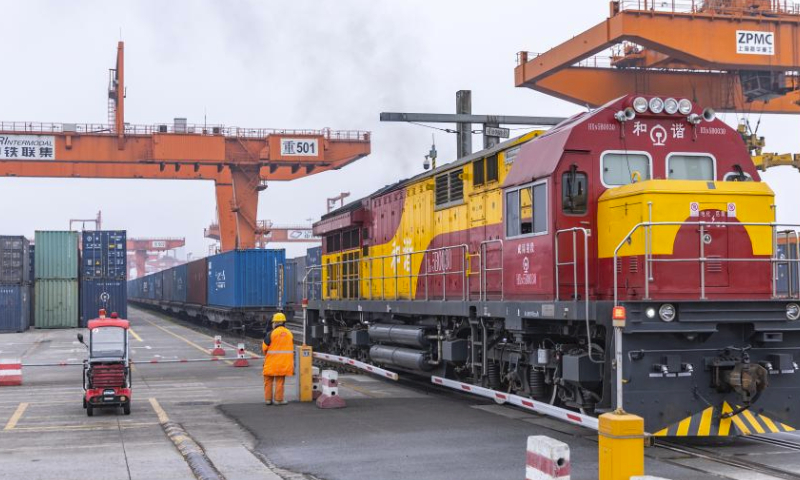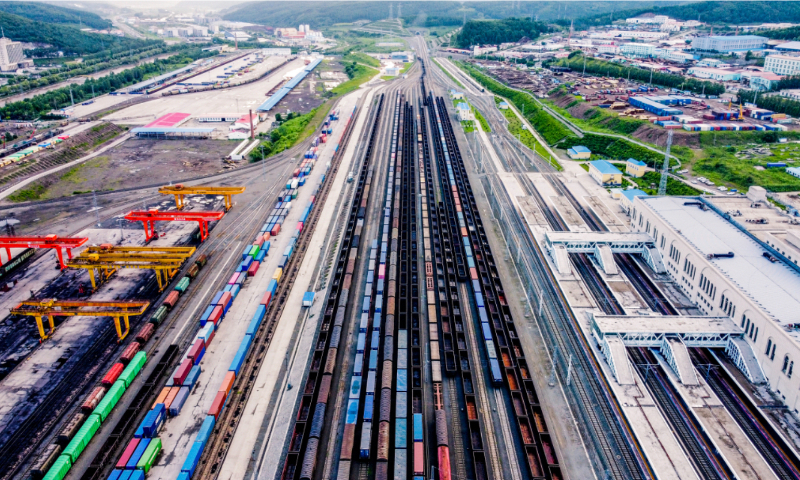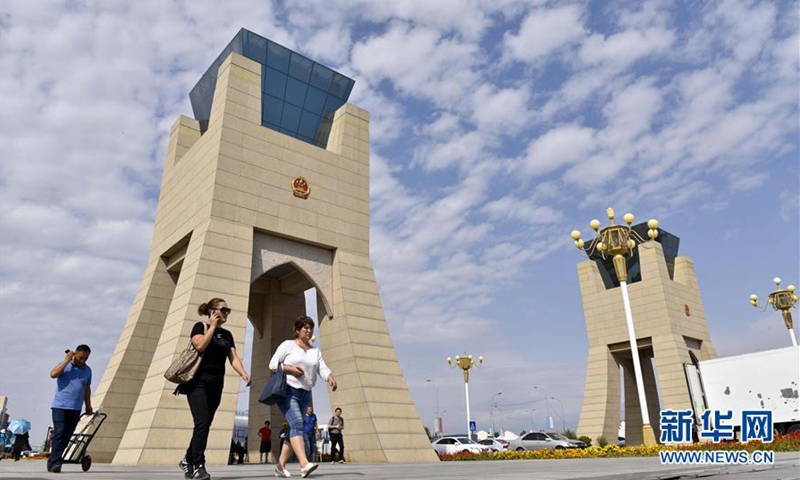Xinjiang continues to improve rail efficiency to better serve China's high-quality opening-up

A train departs from the Urumqi International Land Port Area in Northwest China's Xinjiang Uygur Autonomous Region on May 27, 2024. Photo: Liu Yang/GT
At the foot of the Tianshan Mountains, a number of large trucks carrying steel coils wait in a long line to enter the Urumqi International Land Port Area in Northwest China's Xinjiang Uygur Autonomous Region. On the ground on either side of the trucks, there are containers filled with goods from all over the country.
Inside the land port area, cranes are busy putting the containers onto a train. Then, with loud and clear whistles, the train loaded with 50 containers sets off westward along the foot of the Tianshan Mountains.
This China-Europe freight train has opened up the international channel linking Europe and Asia, and ushered in new opening-up opportunities for the inland city of Urumqi, which is now a key link in the trips of the China-Europe Railway Express (CRE) to the west, as well as an important center for transportation, trade and logistics.
The bustling scene in the Urumqi International Land Port Area mirrors the rapid development of Xinjiang's imports and exports. In 2022, the region's foreign trade volume exceeded 200 billion yuan ($28.2 billion), and it reached 357.3 billion yuan in 2023. In other words, it took 15 years for Xinjiang's foreign trade volume to go from 100 billion yuan to 200 billion yuan, and only one year to go from 200 billion yuan to over 300 billion yuan.
Improving rail services
"After the goods arrive at the land port area, [merchants] can complete the assembly and related formalities within 24 hours and the products will be sent to Horgos Port or Alashankou Port," Ma Yun, an official from China Railway Urumqi Group, told the Global Times on Thursday, adding that previously this process took three to five days.
In March 2024, Xinjiang started its first full timetable for the China-Europe freight trains from Urumqi to Almaty in Kazakhstan, reducing the travel time by more than 60 percent.
"The full timetable for the China-Europe freight trains between Urumqi and Almaty runs every Wednesday, and the more stable and efficient China-Europe trains have become the first choice for more enterprises," Ma said.
At present, Urumqi has 21 routes for China-Europe freight trains, reaching 26 cities in 19 countries. From January to April this year, a total of 435 China-Europe trains departed from the Urumqi International Land Port Area, representing a year-on-year increase of 13.5 percent.
Horgos, which has become a new transportation hub for the China-proposed Belt and Road Initiative (BRI) thanks to the railroads, also makes it a priority to continuously improve the customs clearance services for the China-Europe freight trains.
"With the help of a special network platform, enterprises can complete the related procedures online, which improves the efficiency of the audit. Also, we have strengthened communication with the Kazakhstan customs department, with real-time mutual notification of the train departure and arrival times," Bai Hanguo, an employee of the Urumqi branch of China Railway Container Transport Corp, told the Global Times on Thursday.
According to the Horgos Port Customs, previously, if the train arrived at the port at night, it was necessary to make an appointment for inspection in advance. Now, the customs services are available 24 hours a day, and trains can accept the customs inspection at any time.
Ye Mengting, a salesperson from a freight forwarding company, is responsible for customs clearance of goods. She used to be able to handle one to two trains of cargo a day, "but now I can complete the procedures for three to four trains within one day," Ye told the Global Times.
In 2023, an average of 16 trains passed through the Horgos Railway Port on a daily basis, but this year it increased to more than 20 trains. At present, there are 82 routes for the China-Europe freight trains passing through the inland port, heading to cities in 18 countries.
Win-win results
The opening of the CRE in Xinjiang has enabled many enterprises along the route to benefit from opening up to the outside world.
A leading coal chemical enterprise in Urumqi, which mainly produces caustic soda, PVC and polyester, has taken the opportunity to develop overseas markets, and sells its products to Kazakhstan, Russia, India and other countries. In 2023 alone, more than 2,700 containers of products were exported.
In 2014, the enterprise cooperated with Tajikistan to jointly build a cotton planting and processing industrial park with an area of 1,000 mu (66.7 hectares), which was put into operation in 2016. In response to the backwardness of local planting technology and the lack of modern factories, the enterprise exported advanced planting and processing technology, increasing the local cotton yield from 100 to 400 kilograms per mu.
The processed products are sold to Turkey, Belarus and other countries, providing more than 1,000 jobs for local residents and aiding the development of the local economy and society. "Such cooperation is a win-win situation, which benefits the countries, the people and the enterprises," an official from the company told the Global Times.
Last weekend, the CRE registered over 90,000 trips in total, shipping freight worth over $380 billion. "Transport leads to prosperous industries. The CRE carries goods, but what it brings are opportunities and hope. The CRE not only makes it faster and more convenient for Chinese and European goods to reach each other's markets, but also keeps fostering new logistic services, industries, business centers and industrial parks. It now serves as a bridge for mutually beneficial trade," Mao Ning, a spokesperson for China's Foreign Ministry, told a press conference on Tuesday.
"We will work with countries along the lines to promote high-quality development of the CRE, inject more stability into the world economy and provide more driving force for common development," Mao noted.



